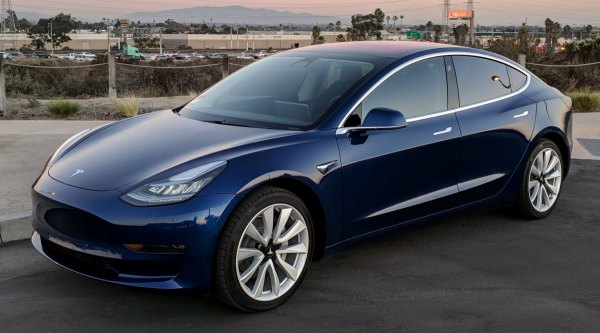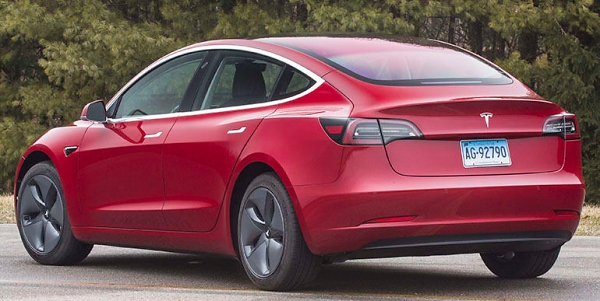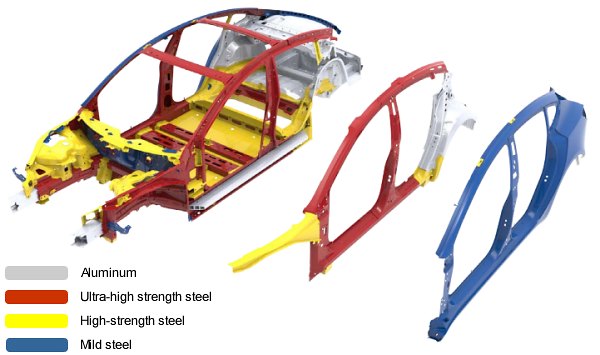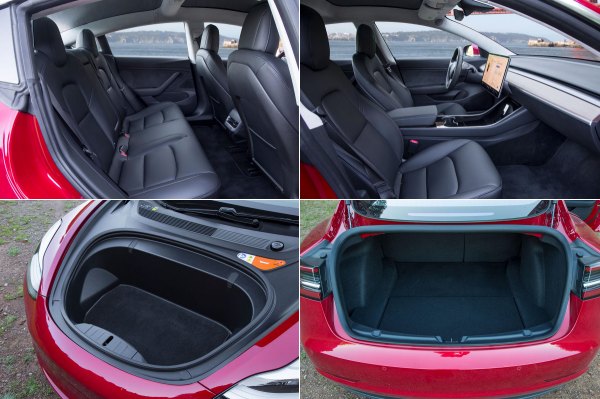| Published
on 18
Jul
2018 |
All rights reserved.
|
|
|

|
|
This
car got 325,000 orders in the first week, but getting the car built is
another matter.
|
|
On the stage where the new
Tesla Model 3 was unveiled, there was a big counter showing how many
orders it had received since the online order book opened merely 24
hours ago. At first it showed 115,000 orders. By the time the event
ended, the number passed 132,000. It sounds very much like the launch
of a new iPhone. One week later, 325,000 orders had been recorded. We
have never seen such a hot initial reception in automotive history.
Admittedly, the deposit for reservation is only US$1000, and it is
refundable upon cancellation. Elon Musk is so clever. He made
good use of news headlines to promote the car.
However, getting orders is one thing, getting the car built is another
matter. To speed up the development process from hand-built “alpha”
prototypes to production cars, Elon Musk made a bold decision to skip
the stage of “beta” prototypes that all conventional car makers have
been adopting for decades. Beta prototypes are built by short-lived
toolings to iron out all the problems before the expensive permanent
toolings are made. Musk believed that his company could use superior
analytical method to iron out the problems and go straight to
production stage. Somehow, this didn’t work. The Model 3 was met with
all kinds of production difficulties, including one you have never
thought of: it had problems welding the steel body of Model 3! We
thought the aluminum body of Model S should be more difficult to weld,
because aluminum dissipates heat much faster than steel. While all
other car makers have no problems to weld steel over the last 100
years, the most advanced car maker in the world has no clue how to weld
steel correctly, God! Without employing the right guys to oversee
its production, the production equipment it ordered did not work
properly, thus
the early production cars were practically hand-built. As a result,
Tesla spent more than a year fighting with the production problems.
Production ramped up slowly while the company was burning its cash
reserves at alarming rate, setting record loss every quarter and
frustrating Wall Street investors. By the time of writing, its
production finally starts taking off, at a rate of 5000 cars per week,
but this is achieved at a heavy cost: Musk installed a second assembly
line at a tent beside the factory, and shifted some workers from the
assembly line of Model S and X. Detroit is laughing.
 |
|
Elon
Musk took a big gamble by skipping Beta prototypes, and it was proved a
costly mistake...
|
|
Anyway, production problems will be overcome sooner or later. What
counts to the car buying public is whether the car good and affordable.
It goes without saying the Model 3 is the cheapest Tesla yet. Its price
starts at $35,000, about the same as the cheapest BMW 3-Series or half
the price of the leanest Model S, although many people may spec. it up
to $60,000. Instead of aiming at Chevrolet Volt or Camry Hybrid, it is
supposed to steal sales from the most popular BMW in the premium class.
If everything goes to plan, the ex-Toyota factory in California will
produce 400,000 units of Model 3 annually (in addition to another
100,000 units of Model S and X, reaching the plant's maximum capacity
of 500,000 units). For your reference, BMW
built 409,000 units of 3-Series last year. Forget Cadillac. Tesla is
the America's biggest threat to BMW.
The Model 3 is much shorter and narrower than Model S, but it is still
a 3-box sedan, and it has a strong family resemblance to its bigger
brother. The biggest difference, however, is the front grille, or the
lack of it. I remember Tesla design chief Franz von Holzhausen said he
gave the Model S a conventional-looking pseudo grille just to play
safe. Once Tesla had been well received, the next design could be more
adventurous. Now the Model 3 is that adventurous design. Its flush nose
might be criticized as "faceless", but that is exactly what makes it
different from conventional cars. I actually quite like it. The
teardrop shape achieves a class-leading Cd of 0.23, matching Mercedes
CLA and Audi A4. Moreover, unlike conventional cars, its drag does not
increase with the introduction of more powerful motors.

|
|
The
teardrop shape achieves a class-leading Cd of 0.23.
|
|
Depending on when the car is built, finish and finish ranges from poor
to acceptable. However, if you place order now, by the time you get the
car delivered (probably sometime in 2020), I would expect the build
quality to be closer to perfect. The use of steel to construct the body
is one of the main reasons why Model 3 is cheaper to build than Model
S. Like the rest of the motor industry, Tesla uses a lot of high and
ultra-high strength steel at critical locations to enhance the rigidity
of safety cell, hence achieving 5-star crash rating. However, the car’s
body-in-white is not entirely steel. Aluminum is employed at locations
subjected to less stress, especially the rear wheel wells and trunk
floor, or at crumple zones like the front bumper supports. Outside,
aluminum panels are used for the front bonnet, trunk lid, door skins
and roof, whereas fenders are steel. Mind you, the aluminum roof is not
available yet because all the cars being built are pricier ones
equipped with panoramic glass roof.
The double-wishbone front suspensions and multi-link rear axle are
similar to those of the Model S, but it skips adaptive dampers and air
springs to save money. The battery is again placed inside the floorpan,
allowing the car to achieve a center of gravity as low as sports cars.
There are 2 battery capacities for selection: 50kWh for the base car or
75kWh
for long-range model. They are good for 220 or 310 miles, respectively,
according to EPA. The long-range model easily trumps Chevrolet Bolt
(238 miles), if not the Model S (up to 335 miles). The battery of Tesla
is built at its own Gigafactory, whose production capacity is enough to
supply 500,000 cars a year. Not only this economy of scale gives Tesla
a cost advantage, the unique battery
chemistry offers higher energy
density than rival LG and Samsung etc. Researchers also disassembled a
Model 3 and found its power electronics are more advanced than other
current EVs, taking less space and weight. Tesla might be a novice in
volume car production, but it is definitely a maestro in electronics.

|
|
To
lower cost, the majority of its chassis is made of steel.
|
|
All Model 3 built up to now have the same permanent magnet motor
driving the rear
wheels. However, different batteries supply different power to the
motor thus enable different output and performance. Annoyingly, Tesla
once again refuses to quote the power output (these days even
Rolls-Royce finds “Adequate power” no longer adequate), so we can just
gather information from all sources and provide a guesstimation as far
as possible: the base model should offer about 258 horsepower, while
the long-range model should be closer to 271 hp and 307 lbft of torque.
If so, it will be more powerful than a BMW 330i (now a four-cylinder
turbo, remember) but less so than a 340i.
The power characteristic of electric motor is different, of course. It
offers a hell lot of torque right from spinning with zero hesitation,
so low-speed acceleration is stronger than conventional cars. On the
negative side, no EVs are lightweight. The Model 3 with long-range
battery weighs as much as 1740 kg. That might be 300kg less than the
lightest Model S, but a BMW 330i is lighter by nearly the same margin.
Still, that instant low-down torque allows the Tesla to win 0-60 mph
sprint by 5.1 seconds to 5.5 seconds. Stretch further, and the
gas-powered BMW starts overtaking. The EV refuses to go any faster than
140mph, whereas the BMW will hit its speed limiter at 155mph. Moreover,
at such a high speed, the battery level of Tesla drops so quickly
that you will immediately lose determination to challenge the German
car.

|
|
A
stiff ride aside, the Model 3 is good to drive... just don't push it as
hard as you would in a 3-Series.
|
|
Powertrain refinement is outstanding. Not only
smooth, it is free of the whine associated with many EV motors. In
fact, even quieter than the Model S.
Weight is the enemy to handling. However, by placing the motor at
the rear axle and the battery – by far the heaviest element of the car
– at the floorpan within the wheelbase, the damage is kept to the
minimum. Its 48:52 front-to-rear weight distribution will make any cars
this side of Ferrari and Maserati envy. It changes direction eagerly,
and body roll is remarkably limited. The steering is hardly feelsome
but at least
it is quick and can be set quite heavy if you switch to Sport mode. In
normal driving, the Model 3 feels agile and holds on well, but push it
harder as you would in a 3-Series, it will run out of grip and
understeer earlier, an implication
of its excessive weight. Meanwhile, the ride is always surprisingly
stiff, transferring too much harshness and noise into the otherwise
refined cabin. It seems that Tesla deliberately stiffened its springs
and
shortened its suspension travel to deal with that extra weight.
Overall,
this is a fine car to drive under normal conditions, just don’t see it
as
an alternative to German executive cars.
The Model 3 runs less regenerative braking than, say, Chevy Bolt and
Nissan Leaf, so one-foot driving is not possible. On the plus side, it
is easier for
conventional car drivers to get used to.

|
|
Cabin
is spacious, and there are 2 trunks.
|
|
One advantage the EV has over its German rivals is packaging. Thanks to
the long, 2875mm wheelbase and the lack of an engine up front, the
cabin can be stretched forward. On the one hand it offers excellent
forward visibility, on the other hand the cabin is spacious – and this
perception is amplified further by the full-length panoramic glass
roof. The flat floorpan means it can seat 5 six-footers, although 4
will be more enjoyable. Rear passengers will find legroom more generous
than the cases of 3-Series or C-class. Despite the slopping roof line,
rear headroom is good, too. However, this is achieved by mounting the
rear seat closer to the floor. As the floor has to contain the battery,
it is slightly higher than that of a conventional car. Consequently,
the rear passengers have their knees up, not a comfortable sitting
position for long journeys.
Up front, the driver enjoys plenty of room and expansive view. The
driver seat is a bit flat and lacking lateral support. Rear view is
poor, blame to the tiny rear window and a high parcel shelf.
With one boot at each end, the Tesla is unbeatable for luggage
carrying. The front boot (“Frunk”) can accommodate a standard
hand-carried airliner
suitcase. It also has hooks to fix shopping bags. The rear boot is not
very deep or wide but it is quite tall (at the expense of rear view).
Between them, 525 liters of luggage can be stored.
 |
|
IT
addicts will love the desktop monitor, while Elon Musk loves its low
cost.
|
|
Given the track record of Tesla, you won’t expect its budget model to
match German premium cars for build quality. Yes, if you look for a
classy interior, go straight to the German brands, especially Mercedes
and Audi. If you are addicted to Silicon Valley technology, you might
be happy to accept the compromises here. The Model 3’s cabin is
designed out of the school of minimalist. It is not quite as tasteful
as Volvo or BMW i3, but nonetheless puts first priority to simplicity
and functionality. To go one step beyond even the Model S in this
direction, it simply ditches the instrument pod ahead of the driver,
relying on solely a centrally-mounted 15-inch LCD screen to display all
the driving information and infotainment simultaneously. IT addicts
will feel at home because it looks just like a desktop monitor – Elon
Musk likes it, too, because China-built desktop monitors are extremely
cheap these days. It looks flimsy, but it is actually quite sturdy. The
large screen enables clear graphics, large icons and well organized
menus. The lack of physical buttons might be annoying to older drivers
but the new smartphone generations don’t care at all, because they are
able to click through multiple menus faster than you can using your fat
fingers to adjust a rotary knob.
The rest of the cabin consists of a simple dashboard decorated with a
large wooden panel, above which hides a full-width air vents – the
direction of air flow and the air-con setting are again controlled
through the touchscreen. It feels high-tech and suitably tasteful in
style, but in general the materials and fit and finish are
workman-grade, especially the uninspiring door panels. Never mind,
Model S has the same weaknesses but it still outsells Audi A8 by 2-to1
globally.
As for software tech, fans of Tesla would be proud of free over-the-air
download and the possibility to upgrade to full autonomous driving in
the future. Currently, the Autopilot 2 system is no more advanced that
what you get in German cars, which includes adaptive cruise control,
auto lane change, collision warning etc. The driving assistance system
doesn’t work as smoothly as some rivals. However, since it is already
equipped with 8 cameras, 12 ultrasonic sensors and a radar, it can be
upgraded to full autonomous driving once Tesla has developed a reliable
software, although that may be still a few years away.
All these optional techs mean the Model 3 can easily top $60,000. It is
not as affordable as Nissan Leaf or Chevy Bolt, obviously, but it is
undeniably the most advanced yet the most practical mass production EV
on the market, one that eclipses our beloved BMW i3. Moreover, it is
the first EV you can consider buying instead of the very best BMW,
Mercedes and Audi. Not quite as versatile or as good to drive, but it
has its own character and strength. Most important, it proves that EV
can finally take the center stage of mass production cars, just like
what Toyota Prius proved for hybrids some 15 years ago.
|
Verdict:     |
Published
on 28
Aug 2018
|
All rights reserved.
|
|
Model 3 Performance
|
|

|
|
Its
0-60mph time might be headline-grabbing, but to build a great
performance saloon demands far more than that.
|
|
Is this the M3 of electric
cars? Tesla thinks yes. I doubt.
In terms of pricing, yes, it is right on the same level. A base Model 3
Performance starts at $65K at its home market, but after all the
essential options (both for performance and comfort) it becomes at
least $75K. That’s about the same price as an M3 or Giulia
Quadrifoglio, not far off the Mercedes-AMG C63 S.
What you get is similar level of power and performance. The Model 3
Performance employs dual-motors, one at each axle, to produce a total
of 450 horsepower and 471 pound-foot of torque (note: Tesla used to
ignore our requests for disclosing output figures, but this time it
realizes the buyers of performance cars do care about figures.) That’s
right in the ballpark of its rivals, if not the best (the Alfa does
510hp and 442lbft, AMG offers 510hp and 516lbft). Since the electric
motors reach maximum torque right from the start, and the Tesla is the
only one in its class (save Audi RS4) benefiting from the total
traction of 4WD, it does 0-60 mph faster than anybody else. Road &
Track timed an eye-popping 3.3 seconds after subtracting the time for
1-foot rollout. However, as speed increases, the traction and torque
advantage fades out. By the time the car reaches 100mph, it is already
overtaken by Alfa Romeo by half a second (if we compare with the test
conducted by Car and Driver). From 60-100mph the Tesla takes 5.3
seconds while the Alfa manages in merely 4.5 seconds. The Alfa
continues to pass 160 mph in 24 seconds while the Tesla slows gradually
to a terminal velocity of 155 mph. BTW, the Alfa will storm pass 190
mph eventually if you find a place to test it. Which one is the
Performance car you want?
While no one has yet to test the Model 3 Performance seriously on
track, putting timing gears and g-force meter to measure its handling
performance, I am quite sure the electric car will lose further ground
to the very best European sports sedans. My rationale comes from not
only the history of Tesla – the Model S P90D and P100D, for example,
are known to be supercar-quick on straight but lukewarm in corners –
but also the technical specifications of this car. First of all, at
1850 kg it is 200 kg heavier than its rivals. Although the Tesla has
its weight positioned low and optimally within the wheelbase for 50:50
balance, weight is still weight on a track. Moreover, this car simply
lacks the chassis upgrade necessary to warrant the claim as a
Performance car. Even if you have opted for the performance package,
which includes a tiny rear spoiler (made of carbon-fiber), bigger
aluminum-hub Brembo front brakes (with 355mm discs and 4-piston
calipers) and 20-inch wheels, the list of modifications is remarkably
lean. The suspension is lowered by only 10mm. Springs and dampers are
virtually unchanged. Adaptive dampers are omitted. Worse still, all
four tires keep a modest width of 235mm, compared with 265-285mm of its
rivals, although the rubbers have been upgraded to Michelin Pilot Sport
4S. More weight, soft suspension and less rubber, it goes without
saying cornering limit should be lower than its rivals.
Admittedly, the weight distribution advantage makes the Tesla feel
agile at lower speeds. If you don’t push it to the limit, it feels
reasonably sporty. If you do push, Road & Track, whose tester
obviously has an especially good relationship with Tesla, claims that
it is as tossable as a hot hatch at the newly added Track mode, as it
oversteers at throttle lift-off and straightens once back on power.
Hey, if you are comparing with some of the greatest rear-drive sports
sedans in the world, hot-hatch handling is not enough, and lift-off
oversteering is always our second choice to power slide. BTW, the
greatest hot hatch handling can be yours for $35K, and that car is
called Honda Civic Type R. More hurting, that $35K purchase includes
adaptive dampers.
If you really believe the Track mode, you might be disappointed by the
overheating issue as well. All road cars overheat on lap after lap of
track abuse, but electric cars suffer more, since their batteries and
electric motors are not designed for sustaining high current
applications. The Model 3 Performance won’t shut down its systems, but
it will reduce power gradually to keep temperatures manageable.
One last thing preventing the Tesla from being an acceptable
performance car is the lack of engine noise and smell of gas. Even at
committed driving its two motors are remarkably silent, emitting
nothing other than a distant, high-pitch whine. I have never been
excited to watch my washing machine spinning, so I suppose won’t be gel
with Tesla either. When you buy a performance car, especially for this
much money and at this performance level, you want not only straight
line acceleration, not only cornering efficiency, but also all the
right noises, smell, vibration and feel that rock straight to your
soul. Silicon Valley entrepreneurs will never understand. They enjoy
only haptic feedback.
|
Verdict:   |
|